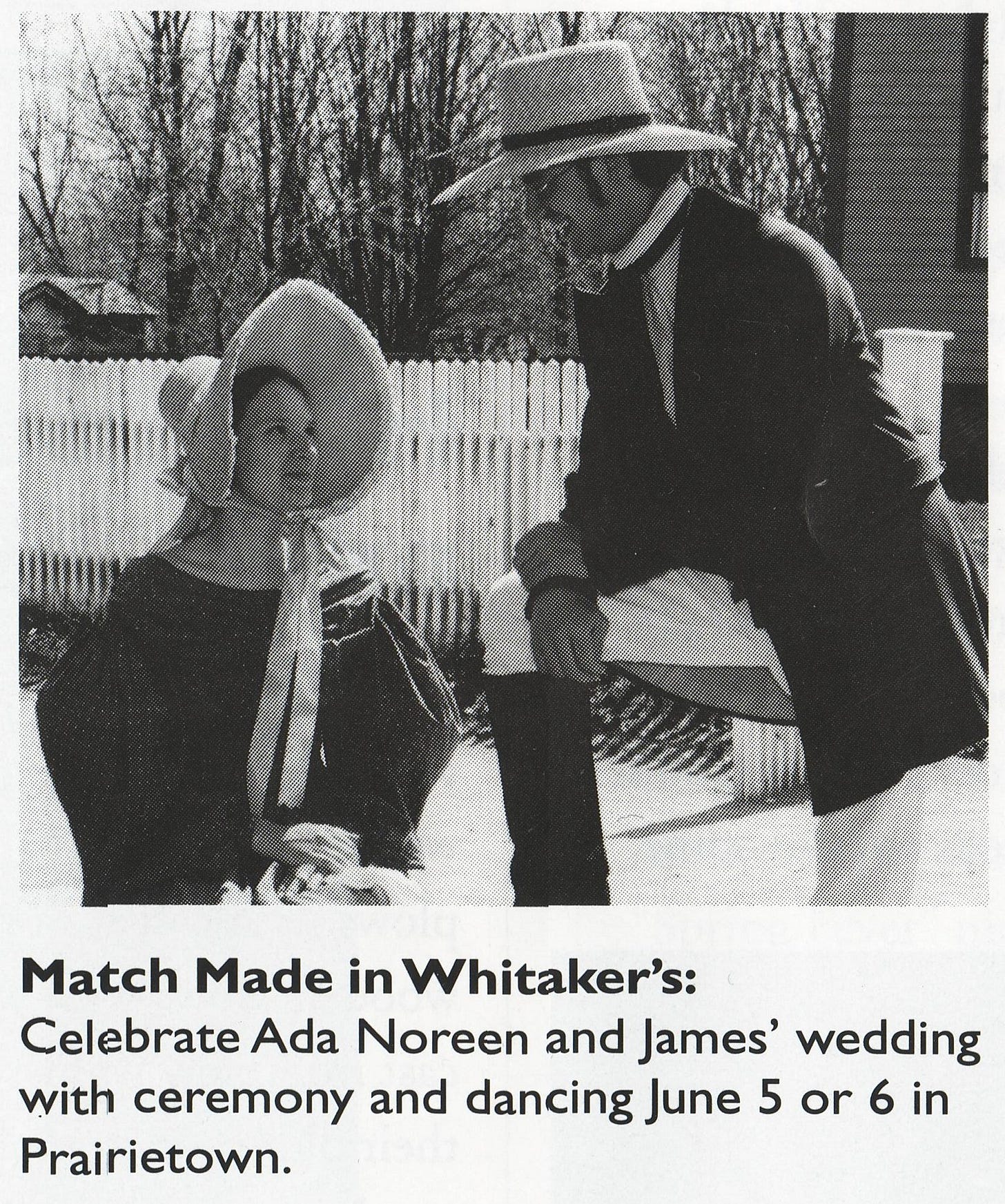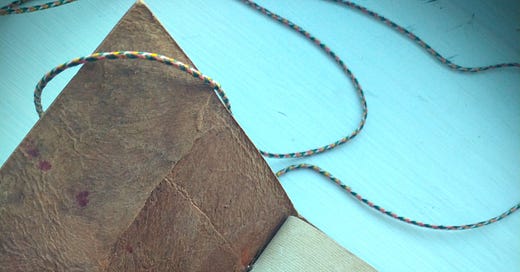Thoughts of an Historical Interpreter
Contemplating the wisdom of my 2002 self.
In a half-hearted effort to clean up my office I was going around collecting all the random journals, diaries and notebooks I have lying around and putting them on one shelf. I love fancy journals and they represent such promise and hope and future planning… However, many of these have only a few used pages because my ADHD brain has a hard time committing to something so set in length.
In my odd assortment of journals I have this little leather one that closes with a cord wrapped around it. At one time the pages were creamy white, but have faded into an aged tan. Imagine my surprise when I opened up to a flashback from 2002 when I was 22 years old and working as an historical interpreter at Conner Prairie in Noblesville, Indiana! I had attempted to record my experiences working there, but only made it a couple of days before I gave up. Ha!
Still, what I read was quite insightful and still refreshingly poignant which I thought I’d share here.
Wednesday, October 23, 2002
I’ve been working at Conner Prairie since October 5th. I wanted to use this book to record my thoughts and feelings while interpreting history. It could be at Conner Prairie or a Civil War event or anything historically related.
In Prairietown I’ve been playing the carpenter’s daughter Ada Noreen McClure. I’ve had a few thoughts while I’ve been portraying her. One thing is that it is absolutely terrible to waste time! There is always something to do and if you put it off it could mean very serious consequences in the future.
Also one day I had a lot of fun boiling beets, then pickling them with eggs. When you’re cooking on the hearth everything has to be timed just right. Not to mention there are never enough hours in the day! Everything has to be saved, nothing wasted. It’s also amazing how physically demanding it is in 1836! I am always so ready for a good deep sleep after working in the village. Even wearing the clothes is physically draining and tiring. It was definitely not an easy time to live in!
December 1, 2002
Yesterday I worked daytime candlelight. As Ada Noreen I had to stuff sausages since the McClure family butchered a few days previous. This was the first time I had ever stuffed sausages. I was a little nervous about it, but sometimes I surprise myself with things I never thought I’d be able to do. A lady got me started in showing me how to stuff the sausage casings and then left me to it with only a youth volunteer to assist me. So I took the casings (cow intestine), put it on the stuffer and pushed the meat into the casings. I was so proud of my first sausage!
I really think they received a lot of satisfaction out of making so many things themselves. Not to mention they had to depend on themselves. We don’t have many, or rather take the opportunities to feel satisfaction for things we do ourselves. So many things are done for us these days. Life evolves around things being easier and more convenient. That’s very sad, you know. It was very satisfying making my own sausages and Conner Prairie will actually be using them next year! How cool is that!
December 10, 2002
Last Saturday with the help of a girl called Jennalee I stuffed sausages again. It was fairly cold inside, but as the day progressed it got warmer outside. Because of the cold one of the stoneware bowls cracked. I had to make a real conscious effort to warm the bowls on the hearth before I put anything very hot in to them.
The museum interpretive season ended after this point and started back up again in April.
April 9, 2003
Today I felt was a good day for me interpreting as Ada Noreen. There was a dad and 2 kids that came at the end of the day. The boy didn’t want to listen about carpentry work and since it was very slow I stayed in the yard and got him away from pumping the well to death and hooked on learning and mastering the skill on the stilts. He did that until he had to leave and I helped him holding onto the stilts until he learned his balance. That felt so good to me and it was the first time EVER that I felt that I could say and do something AS Ada Noreen McClure, not Sarah Creviston pretending to be Ada Noreen. It was wonderful.
Also there was a large group of Mennonite youth/or really teenagers. I can say I had no clue what to talk to them about. So I started in on my thing about my Pa being a carpenter and one of the older boys asked if I knew how much it would cost to build a house. I didn’t know what else to say so I said, “Oh! Are you getting married?” Everyone in that room started laughing and were still laughing when they left. He said, “No.” and I said “Oh, for future reference then." That felt so good! This is what I’ve been trying to achieve with interpreting. This is why I love it so much! And I’m learning slowly, line upon line, one experience at a time what works and what doesn’t.
That last story is hilarious! Haha! I had completely forgotten about that experience.
Reading these journal entries was super nostalgic, but they also reveal some deeper things I had going on. I was so utterly exhausted that I cried in the mornings getting ready for work. (I had another part-time job besides the interpreter position.) A lot of people can work 2 jobs 6 days a week, but this was too much for me. I loved my work at the museum, and I was looking to experience a certain time travel magic of my own while teaching others about Indiana history. But the job was a burden. I felt like my modern knowledge was a handicap in some ways because I couldn’t ever fully immerse myself in 1836—a time period I was still learning about. It felt like I was lying to visitors and to myself. After some time there, I didn’t want to interact with anyone. All I wanted to do was hoe the potatoes in my garden in peace. Not a great emotional place to be as an interpreter.

Needless to say, working in historical interpretive work is a labor of love and it’s absolutely exhausting—physically, mentally and emotionally. But interestingly, these jobs are typically very competitive. This was the case when I applied for the job. People who love history love sharing it with others, and there’s nothing so satisfying and joyous as being fully immersed in history all day long. But, as an interpreter, there’s definitely a cost.
It’s a cost that not many people talk about, but I was grateful the discussion was part of my Public History Survey class last semester. We read Amy M. Tyson’s 2013 book The Wages of History: Emotional Labor on Public History’s Front Lines. This book was so validating to read that there were many instances where I cried out of relief that I wasn’t the only one. That someone understood the toll that it takes to work in that field.
In the book, one historical interpreter, Gideon, described his confusion
“‘between the seductiveness of increased involvement [with one’s place of work] and the desire to maintain personal autonomy.’ For many Fort [Snelling] workers this confusion was exacerbated by one of the demands of the job, which required workers to perform as people other than themselves for much of the day—a job requirement that both attracted people to the job, and yet could also contribute to emotional stress.”1
When I initially read this, I underlined the passage and wrote YES! in the margins. The book is filled with similar markings. It was helping me identify trauma I could feel, but didn’t know existed in a way that could be explained.
I’ve already written about my opinion on first-person interpretation at museums, but when thinking about museum work as I go forward with my Public History masters degree, I frequently think back to my experience working at Conner Prairie. It serves as a reminder to take better care of myself, acknowledge my limitations, and to not be afraid to embrace my philosophies about the best, most rewarding and constructive ways to connect people and history.
Tyson, Amy M. 2013. The Wages of History: Emotional Labor on Public History’s Front Lines. Boston: University of Massachusetts Press, 102.







Right now, I'm totally picturing the stacks of partial journals I have stuffed in every random shelf and cubby, haha! I totally have that same struggle and will start a fresh journal whenever I put too much pressure on the current one. I love that you found that old yellowed diary with your interpretation notes!
This is SO APT and fascinating, and I hadn't yet read that previous article you wrote on first-person historical interpretation. What a helpful glimpse. This is what has prevented me from doing historical interpretation at our Medieval living history museum: I feel like I would particularly struggle with the acting portion, because it would feel inherently incomplete and draining. For instance, at our Medieval museum, there are ferns and undergrowth everywhere (it's essentially in a forested hill)...but in the period we're exploring, that would have been long removed.
I'd much prefer a living history museum that takes a note from the Ruth Goodman shows - in the dress and tradition of the era and explaining the work to visitors, but not pretending.
This was so interesting to read, and definitely an element of historical interpreters that I don't think about. I can imagine that it's very emotionally draining! I loved the story about the Mennonites. What a great post, thanks!